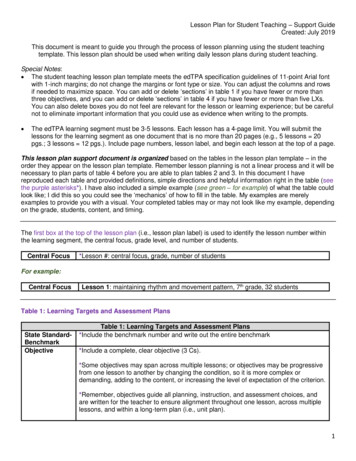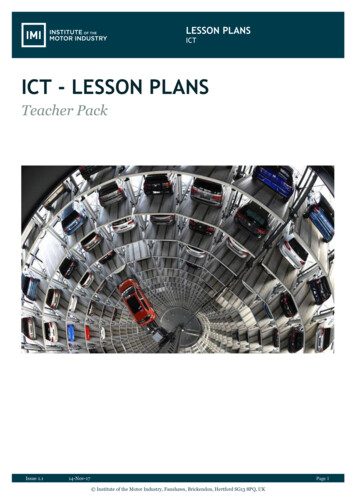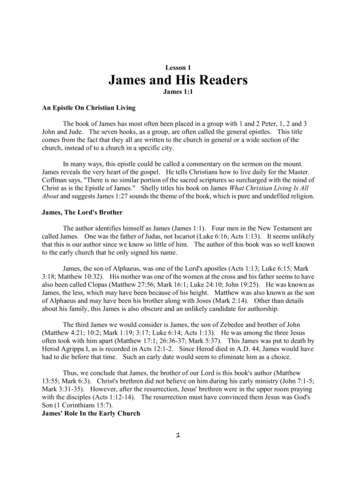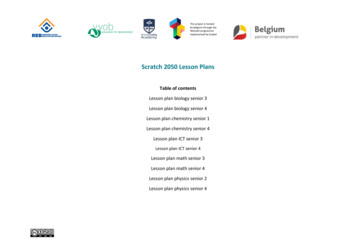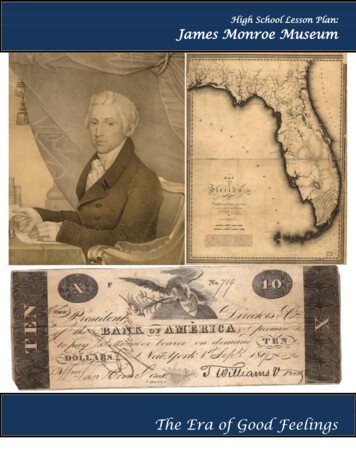
Transcription
High School Lesson Plan:James Monroe MuseumThe Era of Good Feelings
[Type text]Table of ContentsStandards of Learning and ObjectivesPre-Visit PlanOn-Site ActivityPost-VisitDirections345782
[Type text]Standards of Learning: Virginia and U.S. HistorySkillsVUS.1 The student will demonstrate skills for historical and geographical analysis andresponsible citizenship, including the ability to:a) identify, analyze, and interpret primary and secondary source documents,records, and data, including artifacts, diaries, letters, photographs, journals,newspapers, historical accounts, and art, to increase understanding of eventsand life in the United States;b) evaluate the authenticity, authority, and credibility of sources;c) formulate historical questions and defend findings, based on inquiry andinterpretation;d) develop perspectives of time and place, including the construction of maps andvarious timelines of events, periods, and personalities in American history;e) communicate findings orally and in analytical essays or comprehensive papers;f) develop skills in discussion, debate, and persuasive writing with respect toenduring issues and determine how divergent viewpoints have been addressedand reconciled.VUS.6 The student will demonstrate knowledge of the major events from the last decadeof the eighteenth century through the first half of the nineteenth century by:b) identifying the economic, political, and geographic factors that led to territorialexpansion and its impact on the American Indians;e) describing the cultural, economic, and political issues that divided the nation,including tariffs, slavery, the abolitionist and women’s suffrage movements, andthe role of the states in the Union.Objectives: Students will understand the term “Era of Good Feelings” and why it is applied toMonroe’s presidency. Students will think critically about the name “Era of Good Feelings” and analyzewhether or not the title is accurate. Students will be able to identify and interpret a primary source document tounderstand the Panic of 1819.3
[Type text]BackgroundPolitical The Federalist Party dissolved, marking the end of the two parties until afterMonroe’s presidency. He ran for re-election unopposed. Monroe appointed Cabinet members of differing views in an attempt to ease tensions. Monroe toured the states during his presidency. America made the transition to a two party system at the end of Monroe’s secondterm. New states were admitted to the Union during Monroe’s presidency: Mississippi in1817, Illinois in 1818, Alabama in 1819, Maine in 1820, and Missouri in 1821. Rush-Bagot Treaty of 1817: demilitarized the Great Lakes and Lake Champlain,indicating improved relations between the U.S. and Great Britain after the War of1812.Social 1818: A group of Seminole Indians attack American soldiers and their families inGeorgia. Andrew Jackson invades and captures Pensacola in reaction, withoutpresidential authority from Monroe. Monroe returns Florida to the Spanish, but with awarning that Spain must control the Indian population there or cede Florida to theUnited States. 1819: Spain cedes Florida to the United States in the Adams-Otis Treaty. 1820: The Missouri Compromise temporarily addresses the slavery question bydrawing a regional line making Northern states free and allowing slavery in theSouthern states. Maine is admitted as a free state and Missouri as a slave state.Economic The Panic of 1819 was the United States’ first major economic crisis, characterizedby bank failure, foreclosures, unemployment and a drop in manufacturing andagriculture production. Factors contributing to the Panic of 1819 include: inflation caused by debt followingthe War of 1812, the inability of many Americans to pay debt on their homes, as wellas the negative effects from international affairs like the Embargo Act and therecovery of Europe following the Napoleonic Wars. The Second Bank of the United States was founded in 1816. The favorable politicalenvironment of the Era of Good Feelings aided in the establishment of the bank andother new federal initiatives and institutions.Pre-Visit:Students should be familiar with the basic political and economic history of the earlyRepublic, including the Federalist Party and the issues surrounding the creation of anational bank.4
[Type text]On-Location Activity1. Students will divide into two groups. The first group will tour the museum while thesecond completes the activity, then the two will switch.2. Students will watch http://www.youtube.com/watch?v cwvHtkCusHo for anintroduction to Monroe’s presidency.3. Students will tour the “Era of Good Feelings” gallery to learn about Monroe’s terms aspresident. Students will view the painting depicting Monroe’s tour of the Northernstates. What mood does the painting depict? Why do you think Monroe chose to tour these states and what effect do you thinkthe tour had?4. Student will view the peace medal presented to Native American tribes during Monroe’spresidency (JM76.127) and the Pawnee beaded purse presented to Mrs. Monroe(JM76.306.) Students will discuss the relations between the U.S. government and NativeAmericans during this time. What do the peace medal and purse indicate about the relations between theUnited States and Native Americans at the time?(Note: If students are divided into two groups, groups will switch at this point.)5
[Type text]5. Students will read the Second Inaugural Address and discuss the Panic of 1819:Second Inaugural AddressWashington, March 5, 1821"Under the present depression of prices, affecting all the productions of thecountry and every branch of industry, proceeding from causes explained on aformer occasion, the revenue has considerably diminished, the effect ofwhich has been to compel Congress either to abandon these great measuresof defense or to resort to loans or internal taxes to supply the deficiency. Onthe presumption that this depression and the deficiency in the revenuearising from it would be temporary, loans were authorized for the demandsof the last and present year.“Anxious to relieve my fellow-citizens in 1817 from every burthen whichcould be dispensed with, and the State of the Treasury permitting it, Irecommended the repeal of the internal taxes, knowing that such relief wasthen peculiarly necessary in consequence of the great exertions made in thelate war. I made that recommendation under a pledge that should the publicexigencies require a recurrence to them at any time while I remained in thistrust, I would with equal promptitude perform the duty which would then bealike incumbent on me.“By the experiment now making it will be seen by the next session ofCongress whether the revenue shall have been so augmented as to beadequate to all these necessary purposes. Should the deficiency still continue,and especially should it be probable that it would be permanent, the courseto be pursued appears to me to be obvious. I am satisfied that under certaincircumstances loans may be resorted to with great advantage. I am equallywell satisfied as a general rule, that the demands of the current year,especially in time of peace, should be provided for by the revenue of thatyear.”JAMES MONROE What factors does Monroe site for the cause of the economic crisis? What is Monroe’s attitude regarding the potential for an economic recovery? What measures does he recommend to improve the economy? Considering Monroe’s presidency, how do you think this message would have beenreceived? What was Monroe trying to accomplish with this speech? How does this impact theway you read the document?6
[Type text]6. Students will review in the courtyard or introductory room by listing aspects ofMonroe’s presidency that were either congruent or contradictory to the name “Era ofGood Feelings.” What about Monroe’s presidency was harmonious?o One political party (end of Federalists)o Period of economic prosperity before the Panic of 1819o Growth of the United States (new states added) What factors might make Monroe’s presidency not an Era of Good Feelings?o The Panic of 1819o Slavery (Missouri Compromise)o Native American relationsPost-Visit Enrichment Activity:Students will participate in a debate. One side will argue reasons for the title “Era of GoodFeelings” to be applied to Monroe’s presidency; the other will argue that the name ismisleading.7
[Type text]Visiting the James Monroe Museum and Memorial LibraryFor more information about visiting the museum or organizing a class field trip, please call:Phone: (540) 654-1043Or email .Hours:The museum is open from 10 a.m. to 5 p.m. Monday through Saturday and from 1 to 5 p.m.on Sunday. During the months of December, January and February, the museum closes at 4p.m. daily.Directions:The James Monroe Museum and Memorial Library is located in historic downtownFredericksburg, Virginia, only one hour’s drive from Washington, D.C. or Richmond,Virginia.From Interstate 95, take exit 130A to Route 3 East. Follow Business Route 3 past theUniversity of Mary Washington. Continue on Business Route 3 (William Street) to CharlesStreet. Turn right on Charles Street. The museum is housed in a one-story brick building onthe right. On-street parking is available.8
Visiting the James Monroe Museum and Memorial Library For more information about visiting the museum or organizing a class field trip, please call: Phone: (540) 654-1043 Or email _ . Hours: The museum is open from 10 a.m. to 5 p.m. Monday through Saturday and from 1 to 5 p.m. on Sunday. During the months of December, January and February .


